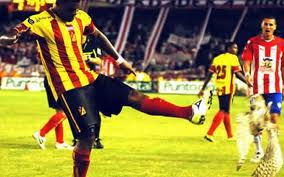27 February 2011 - His Explanation Didn't Fly Either
 On 27 February 2011, a Colombian League match between two struggling teams drew global attention after one player kicked an owl. Popular Junior FC hosted the top flight match against Deportivo Pereira with both teams situated firmly at the bottom of the table. At one point, an owl that served as an unofficial mascot for Junior wandered onto the pitch, where it was soon struck by the ball when a Deportivo player attempted a low clearance. The referee stopped play a few seconds later, at which point Deportivo's Luis Moreno walked over to the injured owl and kicked it off the pitch.
On 27 February 2011, a Colombian League match between two struggling teams drew global attention after one player kicked an owl. Popular Junior FC hosted the top flight match against Deportivo Pereira with both teams situated firmly at the bottom of the table. At one point, an owl that served as an unofficial mascot for Junior wandered onto the pitch, where it was soon struck by the ball when a Deportivo player attempted a low clearance. The referee stopped play a few seconds later, at which point Deportivo's Luis Moreno walked over to the injured owl and kicked it off the pitch.Afterward, Moreno apologized to Junior and their supporters, saying that he was not trying to hurt the owl, but wanted only to see whether it could still fly. The league later determined that Moreno's action was a deliberate provocation of the home fans and suspended him for two games. They also fined him $560.
The owl was sent to a local vet, but died from its injuries. https://tdifh.blogspot.com/2018/02/
People would be forgiven in thinking the team once had a pet owl as the mascot, or some other strigine link. In fact, the reason Sheffield Wednesday are known as ‘The Owls’ is nothing to do with birds, but is everything to do with trees, in particular the Common Alder tree, Alnus glutinosa.
Sheffield Wednesday football club turned professional in April 1887 . It was called ‘Wednesday’ as the players were mainly traders who were only free to play on Wednesdays. In 1898, Sheffield Wednesday moved grounds from their central Olive Grove site, to the suburb of Owlerton, and they took residence at what was then called the Owlerton Stadium. From this point, Wednesday became known as ‘The Owls’; however, ‘the Owls’ of Owlerton have nothing to do with birds. ‘Owls’ or ‘Owler’ is an old Yorkshire dialect word for an Alder tree. The Alder or Owler tree is found in many Sheffield place names, which testifies to the fact that the city was well wooded during its early history, and also that the Alder formed a key tree species of the area. Local place names referring to the Alder include Owler Bar (meaning ‘Alders on the wooded hill’), Owler Car (meaning ‘wet swampy Alder woodland’), and Owlerton (meaning ‘farm in the Alder wood’).
Unaware of the true meaning of the name Owler, the football fans at the new stadium in the district of Owlerton gave Wednesday the nickname of ‘The Owls’, and not ‘The Alders’. This also led to the design of the club’s badge which is dominated by an owl.
In 2016/17 the club revealed a new crest. It is a version of the original club logo and shows a shield with a traditionally drawn owl perched on a branch. It’s possible the original artist was aware of the meaning of Owler and so included a tree branch in the logo – or maybe not. Alder is easily identified by the crimson male catkins and the female cones, none of which are obviously apparent on the club crest and logo. Perhaps in the future, new logo designs could include the addition of some catkins on the branch, which would indicate the Owl is perched on an Alder branch. This would be a nice nod to the arboreal heritage of the club grounds.
The writer Henry Thoreau wrote about the Alder: “If you are sick and despairing, go forth in winter and see the red alder catkins dangling at the extremity of the twigs all in the wintry air, like long, hard mulberries, promising a new spring and the fulfillment of all our hopes.”
Sheffield based AWA Tree Consultants are experts in tree surveys (if not football!), so we would obviously be pleased to see the Alder tree officially recognised. But most long-suffering football fans of any team will appreciate feeling ‘sick and despairing’ at some point during the long winter season. If the Alder catkins do indeed promise the “fulfilment of all our hopes”, it could only be a good thing to include some on the next Sheffield Wednesday crest!
No comments:
Post a Comment